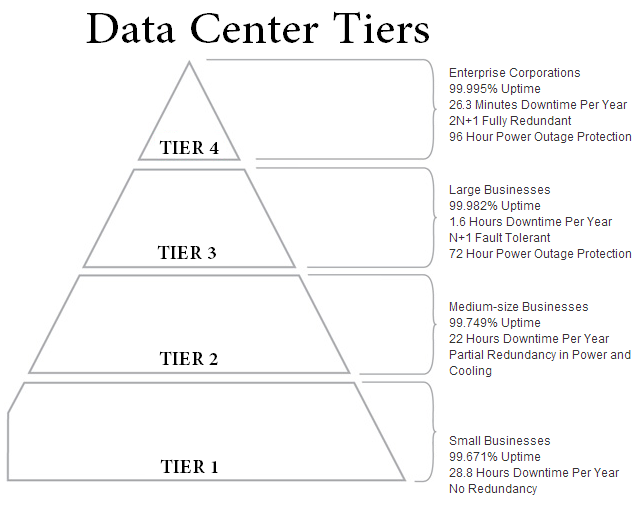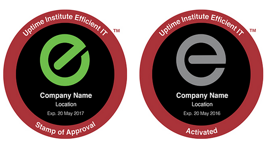
This Week in Getting Hacked: Fembot Edition
September 16, 2015
Friday Fun Blog: Royal Flush Edition
September 18, 2015If you’re in the data center business and not familiar with The Uptime Institute, then you’re probably not a very good data center company.
Their Tier Standards have been classifying and sorting the good data centers from the beefed-up, great ones for over twenty years. But this summer they’ve been particularly busy reworking their tier standard requirements and rewarding data centers for efficiency. Let’s take a look at what the Uptime Institute has been up to:
What Is the Uptime Institute’s Tier Standard System?
Data center tier standards exist to evaluate the quality and reliability of a data center’s server hosting ability. The Uptime Institute uses a somewhat mysterious four-tier ranking system as a benchmark for determining the reliability of a data center. This proprietary rating system begins with Tier I data centers, which are basically warehouses with power, and ends with Tier IV data centers, which offer 2N redundant power and cooling in addition to a 99.99% uptime guarantee.
A Tier III data center is concurrently maintainable, allowing for any planned maintenance activity of power and cooling systems to take place without disrupting the operation of computer hardware located in the data center. In terms of redundancy, Tier III offers “N+1″ availability. Any unplanned activity such as operational errors or spontaneous failures of infrastructure components can still cause an outage. In other words, Tier III isn’t completely fault tolerant. A Tier IV data center is fault-tolerant, allowing for the occurrence of any unplanned activity while still maintaining operations. Tier IV facilities have no single points of failure.

Photo Credit: uptimeinstitute.com
The basic concept is that a Tier IV design requires double the infrastructure of a Tier III design. Note that both Tier III and Tier IV data center specifications require IT equipment to have dual power inputs to permit maintenance of power distribution components between the UPS and IT equipment.
You can read more about the specifics of the Tier Standards on our Tier Standards Overview page.
Why Data Centers Are Now Rewarded for Efficient IT
Way back in May of 2015 The Uptime Institute has added Efficient IT to their rankings for data center tier standards. In their press release Cheif Operating Office of The Uptime Institute stated that:
“Uptime Institute Efficient IT is about better use of resources to better enable the business … Uptime Institute Efficient IT Stamp of Approval codifies the management processes and leadership behaviors that ensure sustained cost savings and resource agility.”
Basically what this means is that rather than what they call “prescriptive requirements” like the cooling, power, etc. listed above, the Efficient IT Stamp of Approval is more or less based on how the data center operates day-to-day and what kind of outcomes they are producing based on certain situations.
The Two Levels of Efficient IT
A data center can be officially stamped for approval by meeting two award levels for Efficient IT:
- Approved
- Activated

Photo Credit: uptimeinstitute.com
To be approved, a data center has to already have been entrenched in meeting the Uptime Institute’s integrity standards for industry excellence. The approval stamp lasts for two years upon when another evaluation will be performed and another stamp will be stamped.
To call yourself activated, your data center must be efficiently working towards meeting the standards of excellence. The activated stamp is valid for a year upon when another evaluation will be performed where you can be upgraded to approved, or given another year of activated.
Efficient IT is quite similar to the Management and Operations (M&O) Stamp of Approval the Uptime Institute delivered back in 2011. They love their stamps—and customers love to see that a data center has these stamps.
What Changed in the Uptime Institute’s Data Center Certification Revisal
In July 2015 The Uptime Institute revised their standards to try and stop some disreputable data centers from fudging their rankings.
The majority of data centers are given the Tier III ranking, but with a little bit of savviness these ranking documents “could be used to substantiate a data center that is designed to one Tier level and constructed and commissioned to another Tier level.”
Uptime has said:
“This amendment is made in response to increased scrutiny from industry groups, oversight mechanisms, and legal bodies in North America into the validity of Tier Certification of Design Documents in the commercial marketplace.”
What does all of this mean, though?
“Uptime Institute is addressing the concern that a Tier Certification of Design Documents could be used to substantiate a data center that is designed to one Tier level and constructed and commissioned to another Tier level.”
So basically, if your data center was given a ranking based on design alone, that particular data center won’t be listed on the Uptime Institute’s website and therefore there hopefully won’t be any confusion about the rankings of a particular data center ever again. But we’ll see.
The Uptime Institute’s efforts to solidify and ensure the efficiency of data centers around the world is truly admirable. There’s a lot of jargon and confusing wording out there in the data center industry that the small business owner looking for colocation or a dedicated server may not understand.
By having these standards in place customers can get that peace of mind knowing that their data is secured in a world-class data center. While their rankings may be a little esoteric at times, at least there’s something out there keeping the data centers in line.
